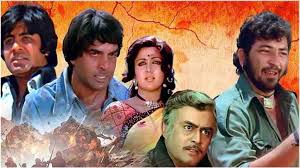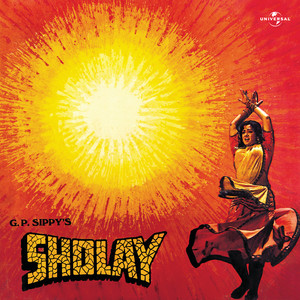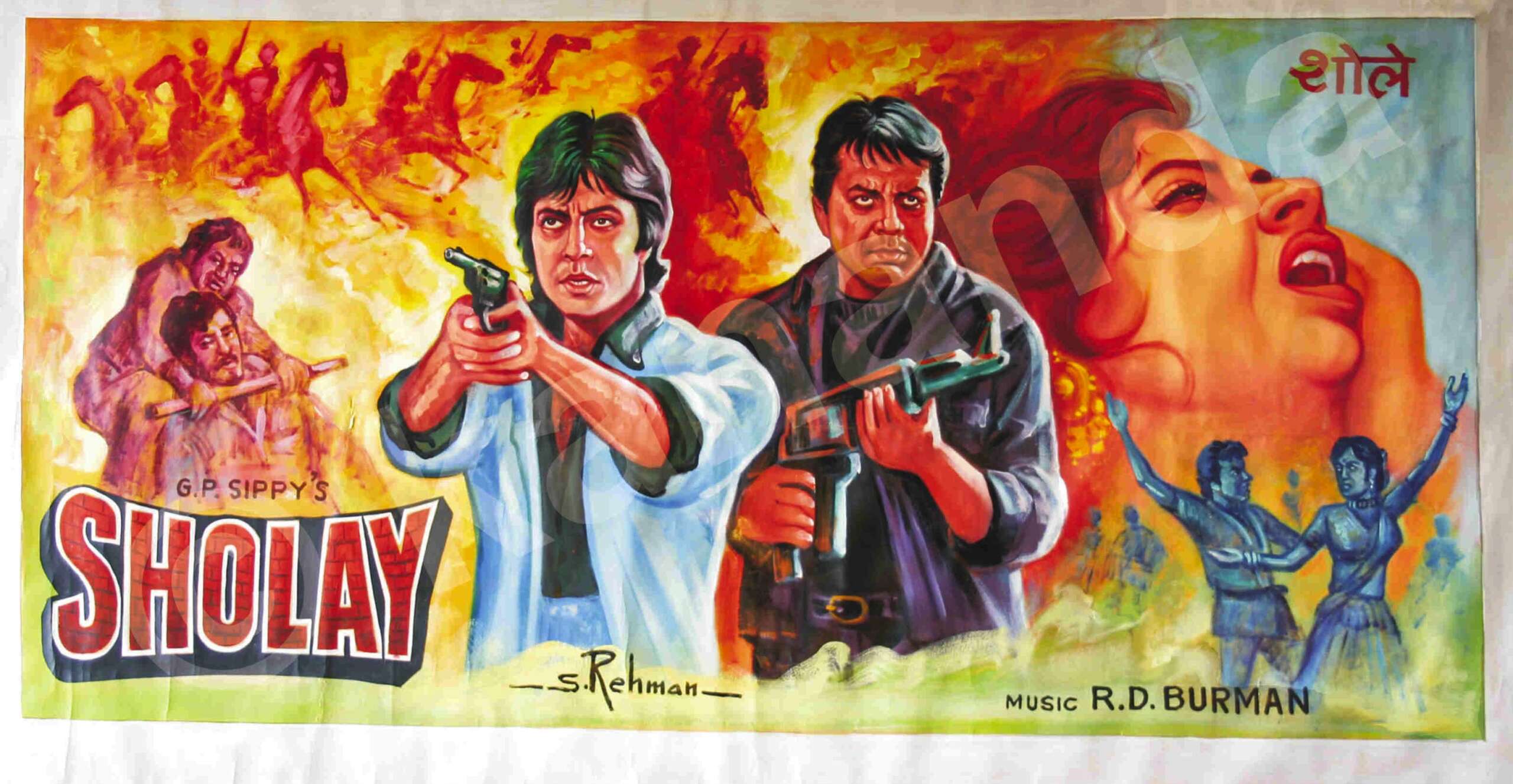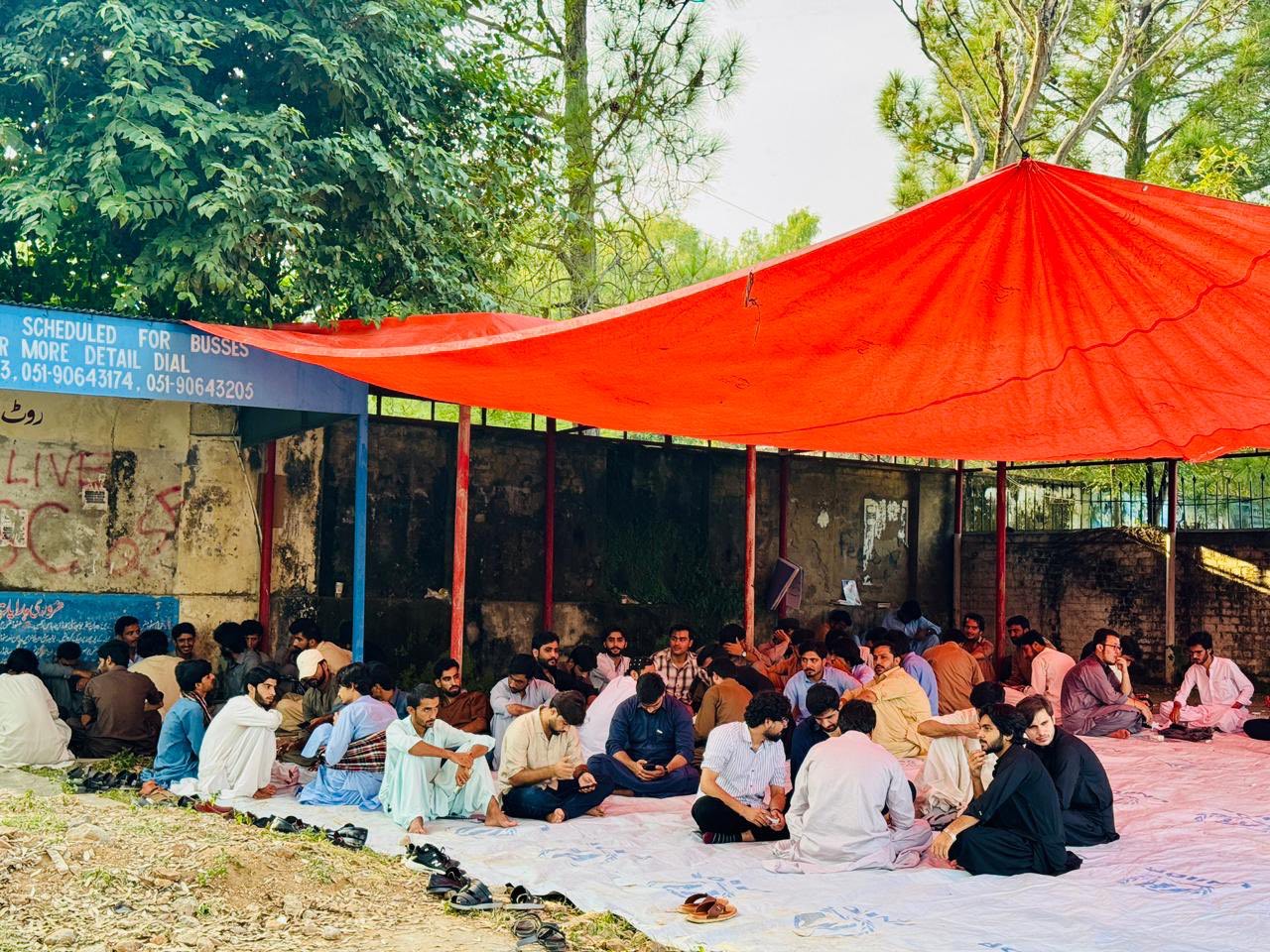Sholay at Fifty: A Cinema Of Enchantment
To understand why Sholay (1975) endures after fifty years, one must recall the late Jesuit scholar Father Gaston Roberge’s pivotal insight that Indian cinema is best understood as anthropological. In The Theory of Indian Cinema (1985), Roberge emphasised that Indian films should not be judged merely by the yardsticks of European realism or Hollywood convention. For him, popular Hindi cinema is best seen as a kind of cultural ethnography—stories that encode myths, kinship, rituals, and archetypes through which society represents itself to itself. Far from being “escapist,” the elements often criticised by Western critics—song-and-dance, ensemble casts, melodrama—are integral to how Indian audiences read their lifeworlds on screen.
Roberge himself offers a conceptual framework for reading Sholay not merely as a blockbuster but as a text of Indian film theory in action. In The Indian Film Theory- Flames of Sholay, Notes and Beyond (2010), he proposes that a movie must be understood by asking what it is, who it is made for, how it is created, and what social truths it embodies. Roberge goes further, aligning Indian cinema with the Fifth Veda, a form of cultural storytelling that educates, delights, and morally moves its audience. Sholay, he argues, enacts an Indian cinematic form, an emotional, ethical, and aesthetic “theory” that resonates with the lifeworld of its viewers.”

Seen through this lens, Sholay is not simply the most celebrated “masala film” but an anthropology of India in the mid-1970s. Its characters embody recognisable social types—the brooding loner, the exuberant companion, the grieving widow, the voluble everywoman—through which heterogeneous audiences could recognise themselves. Its village setting condenses anxieties about authority, violence, and solidarity. Its villain, Gabbar Singh, dramatises the spectre of lawless terror that shadows fragile democracies. What sustains Sholay in memory, then, is not only cinematic craft but its anthropological weight: the way it transforms lived dilemmas into narrative archetypes. These archetypes continue to resonate in modern India, reflecting the enduring relevance of Sholay‘s themes.
The Emergency and the Politics of Disorder
The political climate of Sholay’s release year intensifies this reading. In June 1975, Indira Gandhi declared the Emergency, suspending civil liberties, censoring the press, and jailing opposition leaders. Historian Bipan Chandra, in In the Name of Democracy: JP Movement and the Emergency (2003), has described the period as an authoritarian rupture that profoundly disfigured India’s democratic institutions. Against this backdrop, the allegorical charge of Sholay was palpable. Thakur Baldev Singh, the maimed policeman, embodies the state stripped of authority. Justice can no longer be delivered through institutions and must instead be sought through two outlaws, Jai and Veeru, who hover in the liminal space between criminality and heroism. Gabbar Singh’s arbitrary cruelty, his sadistic laughter, his unrestrained violence, could easily be read as a grotesque allegory of authoritarian power. Audiences did not need allegories spelt out; they read their predicament in these archetypes, finding in Sholay a coded critique as well as catharsis.

The Multi-Starrer as Social Contract
The multi-starrer form of Sholay has often been explained away as commercial insurance, more stars meant greater box-office appeal. But in the anthropological sense that Father Gaston Roberge emphasised, it was also a cinematic mechanism to hold together fragments of a heterogeneous audience. Each character carried the weight of a social type: Jai as the brooding loner, Veeru as the exuberant companion, Basanti as the voluble everywoman, Radha as the grieving widow, Thakur as the wounded patriarch, and Rahim Chacha as the moral elder. Together they represented the multiple energies of Indian social life, energies often fractured by class, caste, gender, or region, yet briefly woven into a single story.
In this sense, the multi-starrer functioned as a kind of social contract. The spectacle of these characters working together against tyranny was more than entertainment—it was a metaphor for a public that longed for collective agency in an era when politics was failing them. The 1970s were marked by class unrest, peasant movements, and regional insurgencies; unity was elusive. Yet in the cinema hall, audiences could experience, even if only symbolically, the possibility of solidarity across difference. As M. K. Raghavendra has suggested, multi-starrers proliferate in periods “when the political situation is complex and difficult to comprehend fully,” and Sholay’s endurance is partly due to its ability to turn political dissonance into narrative cohesion, offering a sense of resolution to the audience.
At the same time, the multi-starrer can be read as crisis management by other means. If the Emergency sought to contain disorder through censorship and repression, the cinema contained it through spectacle and plurality. By distributing narrative attention across archetypes, the multi-starrer prevented any single identity from monopolising the story, offering a fantasy of resolution where politics offered only coercion. The ensemble itself became the message: in the face of lawlessness and authoritarian dread, plurality could still be choreographed into coherence.

This contract was not confined to the film; it extended to the audience. Urban workers, rural migrants, students, women—all could recognise themselves in one or another figure, ensuring that the film’s appeal cut across India’s social divisions. Here, cinema performed a task that politics could not: it offered the experience of belonging to a collectivity larger than the sum of its parts, instilling a sense of unity in the audience.
For all its borrowings from world cinema, foremost among them Sergio Leone’s Once Upon a Time in the West, Sholay became a uniquely Indian classic because it translated political fragmentation into a usable myth of unity. The multi-starrer was thus not a gimmick but a grammar: a way of imagining social life when the nation itself seemed fractured, a way of projecting onto the screen the solidarity that audiences craved but seldom found in reality.
The Village as Nation
Ramgarh, the fictional village, is the film’s ethnographic stage. It’s well, temple, fields, and ravines are not generic backdrops but markers of Indian social life. The ravines, in particular, evoke the Chambal badlands, associated both with legendary dacoits and the absence of effective state authority. They signify the fragility of governance in rural India, which in the 1970s was undergoing land reform, caste conflict, and insurgency.
It is here that Rahim Chacha, the blind imam played by A.K. Hangal, anchors Sholay’s secular ethic. His role is brief but symbolically crucial. When Gabbar’s men kill his son, Rahim Chacha rises in the village assembly not to demand sectarian vengeance but to insist that justice is a responsibility of the entire community. Though blind, he sees with moral clarity that injustice to one family is injustice to all.

Film historian Rachel Dwyer, in Bollywood’s India: Hindi Cinema as a Guide to Modern India (2014), alludes to how mainstream cinema often embeds national ideals within village life. While she does not dwell on Rahim Chacha specifically, her framework illuminates how his presence encodes India’s secular compact: the minority elder as the conscience of the collective. Ramgarh is thus not imagined as a homogeneous Hindu village but as a microcosm of India, where pluralism is essential to survival. That this voice of secularism appears during the Emergency, when India’s constitutional ethos was under siege, only amplifies its resonance. Today, in an era of heightened communal polarisation, Hangal’s dignified performance reads as prophetic, reminding us that the republic’s strength lies in listening to the most vulnerable.
Violence, Fear, and the Cost of Solidarity
One of the film’s most enduring aspects is its ambivalent treatment of violence. The state is powerless; the courts are absent. Justice comes only through extrajudicial struggle. Jai and Veeru’s intervention is necessary but tragic, culminating in Jai’s death.
Film scholar Sumita Chakravarty, in National Identity in Indian Popular Cinema, 1947–1987 (1993), has argued that Indian popular cinema repeatedly stages violence as both necessary and excessive, as a response to political failure but also a reminder of its costs. In this sense, Sholay reflects the crisis of legitimacy in Indian democracy during the 1970s, when Naxalite insurgencies and state repression had raised the question of whether violence could ever be justified. Jai and Veeru’s reluctant heroism encodes this dilemma: solidarity demands sacrifice, but violence leaves wounds that cannot be healed.
At the same time, Sholay makes clear that authoritarianism operates not only through physical coercion but through psychological domination. Nowhere is this clearer than in Gabbar Singh’s dictum: “Jo dar gaya, so mar gaya” — the one who fears is already dead. On the surface, the line is a taunt to his men, a way of asserting control through bravado. But in the allegorical register of the film, it reveals the core of authoritarian rule: fear as the architecture of power.
As thinkers like Hannah Arendt and Ashis Nandy have suggested, authoritarian regimes sustain themselves less by constant violence than by saturating everyday life with dread. Fear pre-empts resistance; it kills the possibility of solidarity before bullets are fired. Gabbar’s sadistic laughter, his arbitrary punishments, and his demand that villagers live perpetually in anxiety all work to establish precisely this climate of submission. His law is not codified in statutes but inscribed in terror.
Yet the film also dramatises counter-gestures. Jai and Veeru’s refusal to be paralysed, Thakur’s unyielding pursuit of justice despite his maiming, Rahim Chacha’s insistence on collective responsibility even after personal loss — all resist the injunction to fear. In their defiance, the film stages the possibility that solidarity, though costly, is the only antidote to authoritarian dread.
Sholay as a Popular Epic
Sholay also functions as a national allegory of loss and survival. Thakur Baldev Singh, the retired policeman whose arms have been cut off, is the maimed patriarch: a wounded state, unable to wield authority. His daughter-in-law Radha embodies grief as a permanent condition, mourning not only personal but collective loss.
Gabbar Singh, meanwhile, is not merely a villain but the embodiment of a colonial legacy as to how colonial categories of “hereditary criminality” haunted postcolonial governance. Gabbar’s gang resembles these stigmatised figures: permanently outside society, marked as irredeemable threats. His sadistic cruelty reveals both the reality of lawless violence and the fragility of the law itself. In this way, Gabbar appears less as an individual dacoit than as a postcolonial spectre—the persistence of colonial violence within independent India.
If Sholay were only a Western-style action film, it would not have endured. Its power lies in its hybrid form: borrowing the wide-screen vistas and horseback chases of the spaghetti western while anchoring its emotional arc in the moral structure of the Indian epic.

Like the Mahabharata, Sholay is a tale of archetypes in conflict: good and evil, loyalty and betrayal, duty and desire. Its dialogues—”Kitne aadmi the?”—function like epic refrains, endlessly repeated and recontextualised. Philip Lutgendorf, in his essay “Is There an Indian Way of Filmmaking?” (2000), describes this quality as the “oral residue” of Indian cinema: repetitions and refrains that make films portable across generations. Sholay’s dialogues have this epic status: endlessly invoked, remixed, parodied, and thus woven into India’s cultural memory.
Sholay’s Anthropological Afterlife
Why does Sholay still resonate half a century later? Because its anthropological density ensures that its archetypes remain usable. The maimed patriarch, the loyal friends, the grieving widow, the grotesque villain—these figures recur in political speeches, advertising slogans, and internet memes. Gabbar Singh has become shorthand for tyranny; Jai and Veeru for friendship; Basanti for spirited resilience.
As Anustup Basu argues in Bollywood in the Age of New Media (2010), the endurance of Hindi cinema lies not only in the films themselves but in their continual remediation across television, advertising, and digital culture. Drawing on Gilles Deleuze’s thought, Basu argues that the seemingly incongruous elements of popular Indian cinema—the song-and-dance sequences jostling with violence, the comic interludes rubbing against melodrama—are not contradictions or signs of an “unfinished” modernity. Instead, they are assemblages: forms that crystallise the historicity of India’s postcolonial situation. In this light, Sholay’s multi-starrer structure appears less a commercial gimmick than a cinematic negotiation of social multiplicity. Its eclecticism is not disorder but a vernacular modernism, staging the coexistence of village elders, outlaws, lovers, and clowns within a single narrative contract. Sholay’s archetypes survive because they circulate far beyond the cinema hall, constantly available for reinterpretation. India’s political dilemmas have not fundamentally changed: authoritarian tendencies, state failures, and the longing for solidarity. Audiences today, like in 1975, recognise themselves in the dilemmas of Ramgarh.

However, as M.K. Raghavendra cautions in Philosophical Issues in Indian Cinema, critical terms borrowed wholesale from Western film theory—”realism,” “melodrama,” even “modernism”—often misfire when applied to Indian cinema without cultural recalibration. This reminder is crucial: to read Sholay anthropologically is not to impose alien categories but to situate it within indigenous idioms of storytelling. The multi-starrer format, for instance, is less a derivative commercial device than part of a native logic of ensemble narration—akin to epic and folk traditions where collective identity, rather than individual protagonism, anchors the tale.
To dwell on Sholay after half a century is to recognise that its actual endurance lies not in the cult of its dialogues or the spectacle of its action, but in the way it captured the texture of Indian life at a moment of fracture. It was a film of archetypes, but those archetypes were never abstract. They were inscribed with the anxieties of the Emergency, the dilemmas of democracy, and the search for collective strength in the face of authoritarianism. In this sense, Sholay was both entertainment and ethnography, a carnival of images that doubled as a mirror of a society wrestling with its contradictions.
Father Gaston Roberge was right to argue that Indian cinema is anthropological, for a film like Sholay tells us as much about India’s democratic imagination as any textbook of political science. And if we also take seriously the idea of a cinema of enchantment, we see how myth and ritual were reassembled on the screen to create a space of collective dreaming. The enchantment was not escapism; it was a way of binding wounds, of offering the possibility that a fractured public could still imagine solidarity.
This is why Sholay has never grown old. Its images still flicker in the national imagination, not because they belong to the past, but because they speak to the unfinished project of India itself. In every reprise of its songs, in every echo of its villain’s laughter, in every recollection of its heroes standing together against tyranny, Sholay reminds us that cinema, at its most potent, is both anthropology and enchantment. It is the story of a people told back to themselves, and in that act of telling, a reminder that fear need not be destiny, and solidarity remains possible.

